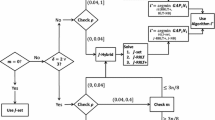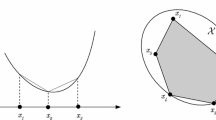Abstract
The best formulations for some combinatorial optimization problems are integer linear programming models with an exponential number of rows and/or columns, which are solved incrementally by generating missing rows and columns only when needed. As an alternative to row generation, some exponential formulations can be rewritten in a compact extended form, which have only a polynomial number of constraints and a polynomial, although larger, number of variables. As an alternative to column generation, there are compact extended formulations for the dual problems, which lead to compact equivalent primal formulations, again with only a polynomial number of constraints and variables. In this this paper we introduce a tool to derive compact extended formulations and survey many combinatorial optimization problems for which it can be applied. The tool is based on the possibility of formulating the separation procedure by an LP model. It can be seen as one further method to generate compact extended formulations besides other tools of geometric and combinatorial nature present in the literature.



Similar content being viewed by others
References
Appelgren L (1969) A column generation algorithm for a ship scheduling problem. Transportation Science 3:53–68
Barahona F (1993) On cuts and matchings in planar graphs. Math Program 60:53–68
Barahona F, Jünger M, Reinelt G (1989) Experiments in quadratic 0–1 programming. Math Program 44:127–137
Barnhart C, Johnson EL, Nemhauser GL, Savelsbergh MWP, Vance PH (1998) Branch-and-price: column generation for solving huge integer programs. Oper Res 46(3):316–329
Bertsimas D, Sim M (2003) Robust discrete optimization and network flows. Math Program 98:49–71
Bertsimas D, Sim M (2004) The price of robustness. Oper Res 52:35–53
Caprara A (1999) Sorting permutations by reversals and Eulerian cycle decompositions. SIAM J Discret Math 12:91–110
Caprara A, Lancia G, Ng SK (2001) Sorting permutations by reversal through branch-and-price. Inf J Comput 13:224–244
Caprara A, Panconesi A, Rizzi R (2003) Packing cycles in undirected graphs. J Algorithms 48:239–256
Caprara A, Carr RD, Lancia G, Walenz B, Istrail S (2004) 1001 optimal PDB structure alignments: integer programming methods for finding the maximum contact map overlap. J Comput Biol 11:27–52
Carr RD, Lancia G (2002) Compact vs exponential-size LP relaxations. Oper Res Lett 30:57–65
Carr RD, Lancia G (2004) Compact optimization can outperform separation: a case study in structural proteomics. 4OR 2:221–233
Chvátal V (1975) On certain polytopes associated with graphs. J Comb Theory Ser B 18:138–154
Conforti M, Cornuéjols G, Zambelli G (2010) Extended formulations in combinatorial optimization. 4OR 8:1–48
Cook WJ, Cunningham WH, Pulleyblank WR, Schrijver A (1998) Combinatorial optimization. Wiley, New York
Dantzig GB, Fulkerson R, Johnson SM (1954) Solution of a large-scale traveling salesman problem. Oper Res 2:393–410
de Carvalho JMV (1999) Exact solutions of Bin-Packing problems using column generation and branch-and-bound. Ann Oper Res 86:629–665
de Carvalho JMV (2002) LP models for bin packing and cutting stock problems. Eur J Oper Res 141:253–273
De Simone C, Rinaldi G (1994) A cutting plane algorithm for the max-cut problem. Optim Methods Softw 3:195–214
Fiorini S, Massar S, Pokutta S, Raj Tiwary H, de Wolf R (2012) Linear vs. semidefinite extended formulations: exponential separation and strong lower bounds. In: 44th ACM symposium on theory of computing (STOC 2012), New-York, NY, USA
Fischetti M, Monaci M (2012) Cutting plane versus compact formulations for uncertain (integer) linear programs. Math Program Comput 4:239–273
Fischetti M, Lancia G, Serafini P (2002) Exact algorithms for minimum routing cost trees. Networks 39:1–13
Gerards AMH, Schrijver A (1986) Matrices with the Edmonds–Johnson property. Combinatorica 6:365–379
Gilmore PC, Gomory RE (1961) A linear programming approach to the cutting stock problem. Oper Res 9:849–859
Gilmore PC, Gomory RE (1963) A linear programming approach to the cutting stock problem-II. Oper Res 11:863–888
Goldman D, Istrail S, Papadimitriou C (1999) Algorithmic aspects of protein structure similarity. In: Proceedings of the 40th annual IEEE symposium on foundations of computer science, pp 512–522
Grötschel M, Holland O (1991) Solution of large-scale travelling salesman problems. Math Program 51(2):141–202
Grötschel M, Jünger M, Reinelt G (1987) Calculating exact ground states of spin glasses: a polyhedral approach Heidelberg Colloquium on Glassy Dynamics. Springer, Berlin
Hu TC (1974) Optimum communication spanning trees. SIAM J Comp 3:188–195
Kaibel V (2011) Extended formulations in combinatorial optimization arXiv, preprint arXiv:1104.1023
Kaibel V, Pashkovich K (2011) Constructing extended formulations from reflection relations integer programming and combinatorial optimization XV. In: Günlük O, Woeginger G (eds) Lecture Notes in Computer Science 6655. Springer, Berlin, pp 287–300
Lancia G, Serafini P (2011) An effective compact formulation of the Max Cut problem on sparse graphs. Electron Notes Discret Math 37:111–116
Lancia G, Carr RD, Walenz B, Istrail S (2001) 101 optimal PDB structure alignments: a branch-and-cut algorithm for the maximum contact map overlap problem. In: Proceedings of 5th ACM international conference on computational molecular biology (RECOMB), pp 193–202
Lancia G, Rinaldi F, Serafini P (2011) A time-indexed LP-based approach for min-sum job-shop problems. Ann Oper Res 86:175–198
Lenhof HP, Reinert K, Vingron M (1998) A polyhedral approach to RNA sequence structure alignment. J Comput Biol 5:517–530
Martin K (1991) Using separation algorithms to generate mixed integer model reformulations. Oper Res Lett 10:119–128
Monaci M, Pferschy U (2011) On the robust knapsack problem. SIAM J Optim 23:1956–1982
Monaci M, Pferschy U, Serafini P (2013) Exact solution of the Robust Knapsack problem. Comput Oper Res 40:2625–2631
Newman A (2008) Max Cut. In: Kao Ming-Yang (ed) Encyclopedia of algorithms. Springer, USA, pp 1–99
Padberg M, Rinaldi G (1991) A branch-and-cut algorithm for the resolution of large-scale symmetric traveling salesman problems. SIAM Rev 33(1):60–100
Stoer M, Wagner F (1994) A simple mincut algorithm. In: Proceedings of ESA 94, lecture notes in computer science, vol 855. Springer, Berlin, pp 141–147
Wu BY, Lancia G, Bafna V, Chao KM, Ravi R, Tang CY (1999) A polynomial-time approximation scheme for minimum routing cost spanning trees. SIAM J Comp 29:761–778
Author information
Authors and Affiliations
Corresponding author
Rights and permissions
About this article
Cite this article
Lancia, G., Serafini, P. Deriving compact extended formulations via LP-based separation techniques. 4OR-Q J Oper Res 12, 201–234 (2014). https://doi.org/10.1007/s10288-014-0262-7
Received:
Revised:
Published:
Issue Date:
DOI: https://doi.org/10.1007/s10288-014-0262-7




